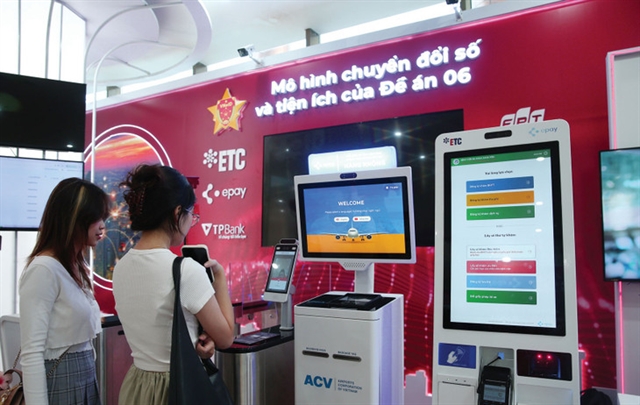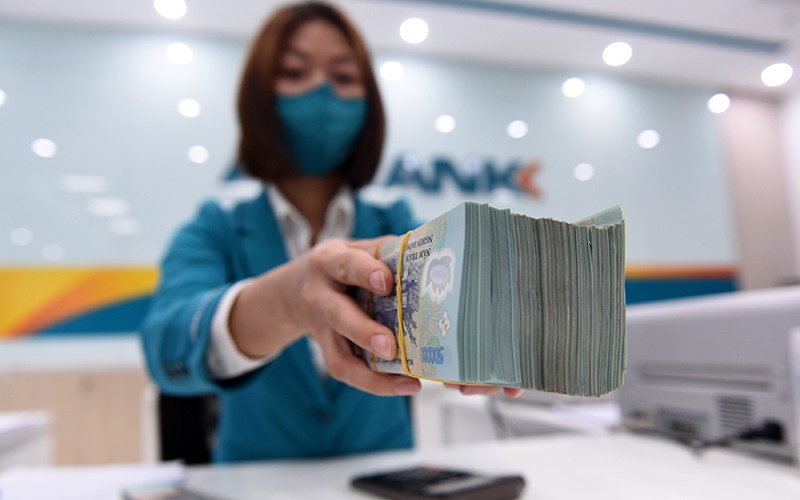 Business Beat
Business Beat

Interest rates on the interbank market have been rising relentlessly, with the overnight interest ratebeing hiked five timesin less than a month.

|
Interest rates for one week, one month, three months and six months also increased sharply to1.46 per cent, 1.5 per cent, 1.77 per cent, and 2.8 per cent. Photo nhandan.com.vn
Thiên Lý
Interest rates on the interbank market have been rising relentlessly, with the overnight interest ratebeing hiked five timesin less than a month.
It rose from 0.25 per cent on April 1 to 1.2 per cent on April 28.
Interest rates for one week, one month, three months and six months also increased sharply to1.46 per cent, 1.5 per cent, 1.77 per cent, and 2.8 per cent.
Analysts said a decrease in liquidity in the banking sector has been the main reason for the rate hikes.
The director of a joint stock bank in HCM City confirmed that liquidity in his bank decreased in the first quarter of the year.
Market observers pointed out that transactions on the interbank market kept increasing in April due to the lower liquidity, with overnight transactions, the most common, reaching a daily turnover level of VNĐ113 trillion from around VNĐ80 trillion in previous months.
According to the General Statistics Office, by March 19 bank deposits had only grown by 0.54 per cent for the year while credit growth was 2.93 per cent.
This significantly narrowed what used to be a wide gap between deposit and credit levels.
The reason for this was attributed to a surge in businesses’credit demand as they sought to grasp opportunities thinking the Covid-19 pandemic had been brought fully under control.
The recent land “fever” in the country has also attracted a lot of money from banks, increasing credit growth.
Data from the State Bank of Việt Nam (SBV) shows that credit growth rose from 2.93 per cent at the end of March to 3.34 per cent by April 16.
Meanwhile, banks have relentlessly cut deposit interest rates and they are now at very low levels, inducing many people to withdraw their savings and invest in other more profitable asset classes like property and securities.
If this trend continues, many banks would have to increase deposit interest rates again, analysts said.
Impacts
The sharp increase in the interbank interest rates is expected to have an impact on both corporate and retail lending since loan interest rates will not be cut further and may even increase since banks have to compete to attract deposits.
Banking sector insiders said however the interest rates on the interbank market are uponly due to seasonal demand, explaining that in April there were long holidays and so banks needed to ensure liquidity for emergencies and to pay off short-term debts.
And there are still a number of factors at work that support stability in interest rates now as well as in future, they said.
Though prices of several goods and services have recently shown signs of rising, the inflation rate remains low with the consumer price index (CPI) in the first four months of the year rising by 1.27 per cent, much lower than the 2.7 per cent in the same period last year, they said.
From the third quarter onwards banks’ liquidity will improve significantly since they will sell large amounts of foreign exchange to the central bank as contracted at the beginning of the year.
It is a known fact that the money injected by the SBV to buy foreign currencies from banks play a very important role in improving the latter’s liquidity.
Free online banking services
More and more banks are scrambling to offer free services after the Covid-19 pandemic returned. On April 26 the Bank for investment and Development of Việt Nam launched the B-free programme with various categories, becoming the second state-owned bank to offer free online money transfers.
Vietcombank was the first, offering several free services to individual customers when they carry out online transactions.
In February it had introduced free of charge services VCB Eco, VCB Plus, VCB Pro, and VCB Advanced.
But market observers said state-owned banks are late in offering such free services compared to their private rivals, many of which had started doing it even before the pandemic began.
The purpose of offering the free services is to develop their online payment services and offer support to corporate and individual customers, many of whom have been badly affected by the pandemic, they said.
But the free services are managing to rope incurrent accounts, which carry lower interest rates than term deposits, and are thus a cheaper source of funds for the banks.
Reports from several banks show their current accounts have grown significantly since the time they began to offer the free services.
Techcombank is known to be a champion in this regard with a rate of 46.1 per cent of total deposits last year.
In the first quarter of this year, its current account deposits rose by 67.9 per cent year-on-year to VNĐ127.2 trillion, while term deposits increased by only 0.6 per cent to VNĐ160.3 trillion.
In second place is MB, whose current account deposits exceed 39 per cent, and in third is Vietcombank with around 30 per cent.
Why do the banks like current accounts?
Analysts said a high demand deposit ratio is imperative for banks since it helps lower their cost of funds.
Normally, interest rates on demand deposits are significantly lower than on term deposits at around 0.2 per cent usually.
A higher ratio also reflects a bank’s strength in having a comprehensive product suite since many value-added products and services are linked to customers’ current accounts.
Finally, a high ratio is an indicator that a lender can acquire and retain customers by offering a strong digital platform and constantly enhancing the customer experience.
Techcombank for instance brought a lot of its products and services online in 2020. They range from everyday banking products and issuance of pre-approved credit cards to financial management and trading of investment products.
It has proven to be effective and convenient by helping save time and cost for customers.
In summary, free digital banking services are of great benefit to both lenders and customers, analysts said. — VNS




